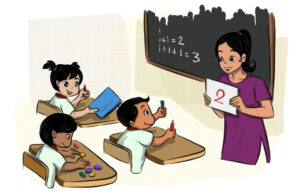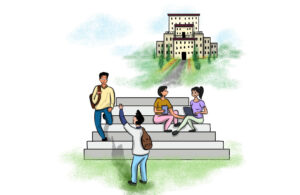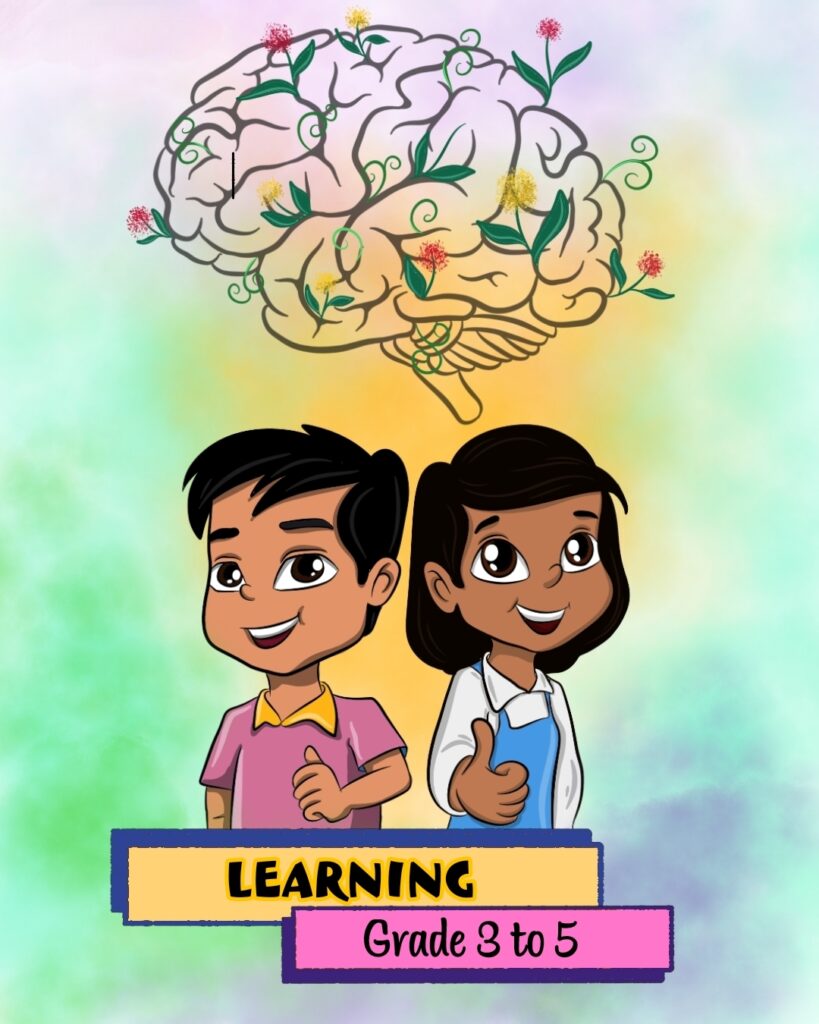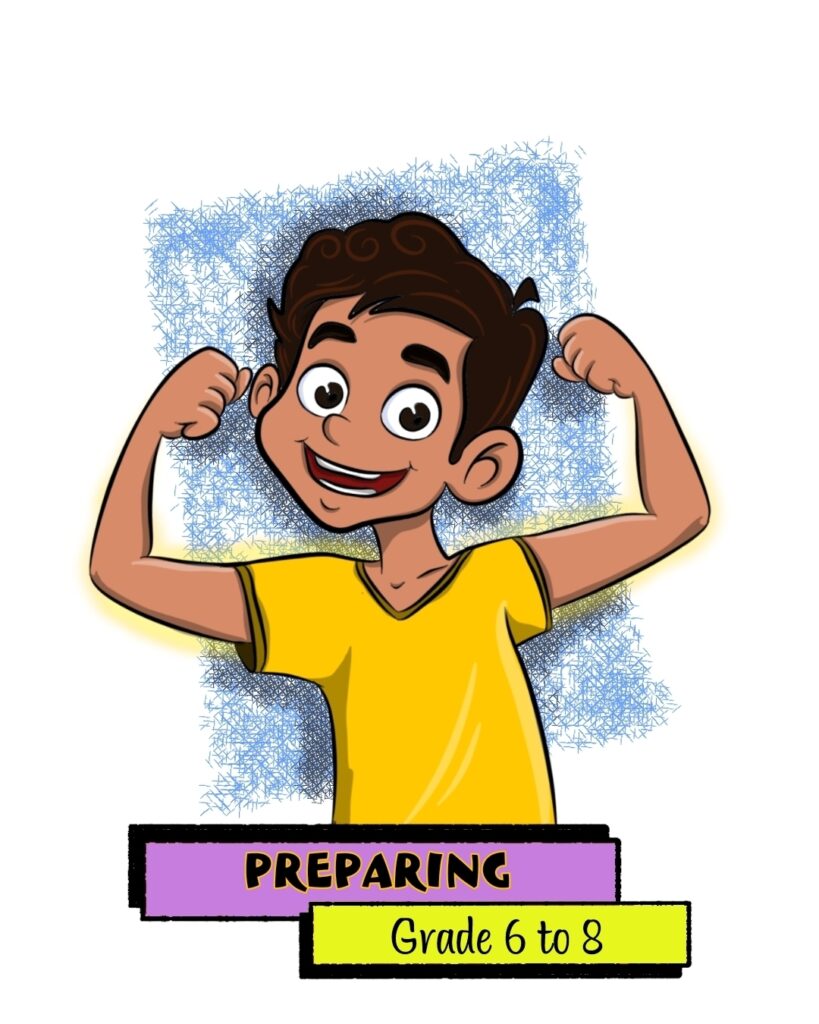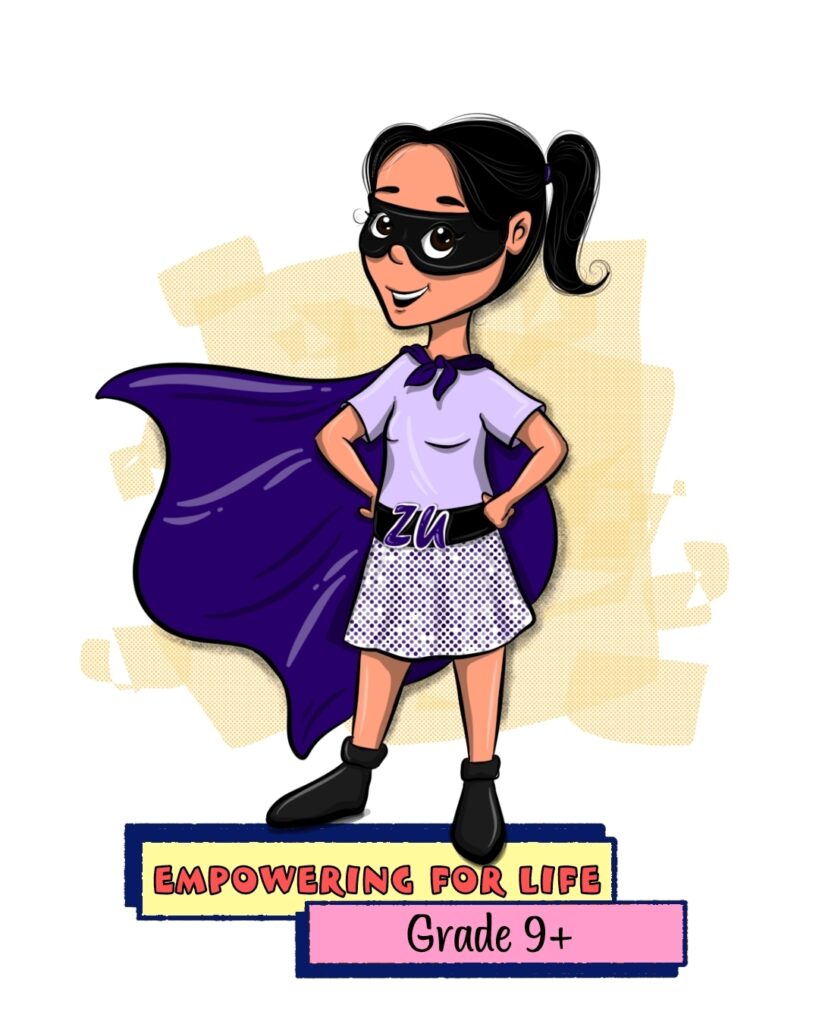Promoting Safety
Children can face a wide range of safety risks as they navigate their daily lives.
According to data from the National Crime Records Bureau (NCRB), accidental injuries are a leading cause of death and disability among children in India. In 2019, over 40,000 children died due to accidental injuries, and many more were injured or disabled.
Teaching about Promoting Safety at a young age helps children in the Prevention of injuries, Building confidence and independence, Developing critical thinking skills, Learning responsibility and life-long empowerment.
Teaching about safety at a young age is crucial for preventing injuries and ensuring well-being. By educating children about common safety risks and providing them with the tools and knowledge they need to stay safe, we help reduce the incidence of accidents and improve your children’s health and quality of life.
In our classes on Promoting safety, we enable students to
- Follow appropriate safety rules when riding in or on a motor vehicle.
- Avoid driving a motor vehicle—or riding in a motor vehicle driven by someone—while under the influence of alcohol or other drugs.
- Use safety equipment appropriately and correctly.
- Apply safety rules and procedures to avoid risky behaviours and injury.
- Avoid safety hazards in the home and community.
- Recognize and avoid dangerous surroundings.
- Get help for oneself or others when injured or suddenly ill.
- Support others to avoid risky behaviours and be safe.
Each lesson is designed meticulously with the help of global experts, our classes are not only age-appropriate but also culturally appropriate according to the region and state you are watching the classes in. We also customize the classes to fit the requirements of each school.
We follow eight step learning process to ensure life long positive impact on your children. You can also see grade-wise learning objectives and lesson plans in the curriculum.
We are ZatchUp and we are dedicated to empowering your child to make healthy and safe life choices. Thank you
Grade wise learning objective
We follow an 8-step learning process to empower the kids for life. To learn more about our method of teaching, click here.
KG – Grade 2
- Step One: Step one is Understanding the Core Concept : We enable Students to comprehend core concepts related to our all health and safety courses such as consent, violence prevention
- State the benefits of riding in the back seat when a passenger is in a motor vehicle.
- Describe the importance of using safety belts, child safety restraints, and motor vehicle booster seats.
- Identify safe behaviors when getting on and off a bus and while riding on a bus.
- Identify safety rules for playing on the playground, swimming, and playing sports.
- Identify all situations in which it is important to wear a helmet.
- Describe how injuries can be prevented.
- Identify safety rules for being around fire.
- Describe how to be a safe pedestrian.
- Identify safety hazards in the home.
- Identify how household products are harmful if ingested or inhaled.
- Identify safety hazards in the community.
- Identify people who can help when someone is injured or suddenly ill.
- Identify ways to encourage others to stay safe.
- Step Two : Second step is to Understand Influences : We enable Students to analyze the influence of family, peers, culture, media, technology, and other factors on their health and Safety.
- Identify how family can influence safety and injury prevention practices and behaviors.
- Identify how school can influence safety and injury prevention practices and behaviors.
- Identify how media and technology can influence safety and injury prevention practices and behaviors.
- Describe positive influences on safety and injury prevention practices and behaviors.
- Describe negative influences on safety and injury prevention practices and behaviors.
- Step Three : Third step is to learn to access Information : We enable students to access valid information, products, and services to ensure good health and safety.
- Identify trusted adults at home who can help promote safety and injury prevention.
- Identify trusted adults and professionals in school who can help promote safety and injury prevention (e.g., school principal, facility and maintenance staff).
- Identify trusted adults and professionals in the community who can help promote safety and injury prevention (e.g., healthcare provider, police officer, firefighter, religious leader, mentor dispatcher).
- Explain how to locate school health helpers who can help promote safety and injury prevention (e.g., school nurse, facility and maintenance staff).
- Explain how to locate community health helpers who can help promote safety and injury prevention (e.g., healthcare provider, police officer, firefighter, religious leader, mentor).
- Demonstrate how to locate school or community health helpers to enhance safety and injury prevention (e.g., locate principal’s office, find “safe-zone” at school, call dispatcher).
- Step Four: Fourth step is to learn Interpersonal Communication : We enable students to use interpersonal communication skills to enhance health and reduce all health risks.
- Demonstrate how to effectively communicate needs, wants, and feelings in healthy ways to promote safety and prevent injury.
- Demonstrate effective active listening skills including paying attention, and verbal and nonverbal feedback to promote safety and avoid or reduce injury.
- Demonstrate effective refusal skills, including firmly saying “no” and moving away, to avoid or reduce injury.
- Demonstrate how to effectively tell a trusted adult when feeling threatened or harmed.
- Step Five : Fifth step is to learn to make decisions : We enable students to use decision-making skills to enhance healthly behaviour.
- Identify situations that need a decision related to safety and injury prevention.
- Identify how family, peers, culture, technology, or media influence a decision related to safety and injury prevention.
- Explain the potential positive and negative outcomes from a decision related to safety and injury prevention.
- Describe when help is needed and when it is not needed to make a decision related to safety and injury prevention.
- Step Six : Sixth step is to learn to Set Goals : We enable Students to set the right goals to enhance their health and keep themselves safe.
- Identify a realistic personal short-term goal to avoid or reduce injury.
- Take steps to achieve a personal goal to avoid or reduce injury.
- Identify people who can help achieve a personal goal to avoid or reduce injury.
- Step Seven : Seventh Step is learn Self-Management : We enable students to practice health-enhancing behaviours and reduce health risks.
- Identify practices that promote safety and reduce or prevent injuries.
- Demonstrate safety and injury prevention practices.
- Commit to practicing safety and injury prevention behaviors.
- Step Eight : Eigth step is learn to Advocate : We enable Students to advocate not only for personal, but also for family, and community health.
- Make requests to others (e.g., family members) to promote safety and avoid or reduce injury.
- Demonstrate how to encourage peers to be safe and avoid or reduce injury.
Grade 3 – Grade 5
- Step One: Step one is Understaning the Core Concept : We enable Students to comprehend core concepts related to our all health and safety courses such as consent, violence prevention
- Explain how injuries can be prevented.
- List examples of dangerous or risky behaviors.
- Identify ways to reduce risk of injuries while riding in a motor vehicle.
- Describe how to safely ride a bike, skateboard, scooter, and/or use inline skates.
- Identify when it is important to wear a helmet and/or other appropriate protective gear when participating in sports or other physical activity.
- Identify ways to reduce injuries in case of a fire.
- Identify ways to reduce risk of injuries around water.
- Identify ways to reduce injury from falls.
- Identify ways to protect vision or hearing from injury.
- Identify ways to reduce injuries from firearms.
- Identify ways to reduce injuries as a pedestrian.
- Identify safety precautions for playing and working outdoors in different kinds of weather and climates.
- Identify ways to reduce risk of injuries from animal and insect bites and stings.
- List ways to prevent injuries at home.
- Describe how to avoid injuries when preparing food or cooking.
- Explain why household products are harmful if ingested or inhaled.
- List ways to prevent injuries in the community.
- List ways to prevent injuries at school.
- Describe how sharing or posting personal information electronically about self or others on social media sites (e.g., chat groups, e-mail, texting, websites, phone and tablet applications) can negatively impact personal safety of self and others.
- Explain what to do if someone is poisoned or injured and needs help.
- Identify ways to encourage others to reduce risk of injuries and stay safe.
- Step Two : Second step is to Understand Influences : We enable Students to analyze the influence of family, peers, culture, media, technology, and other factors on their health and Safety.
- Identify how culture influences safety and injury prevention practices and behaviors.
- Identify how peers influence safety and injury prevention practices and behaviors.
- Identify how community influences safety and injury prevention practices and behaviors.
- Describe how family and culture influence safety and injury prevention practices and behaviors.
- Describe how school and community settings influence safety and injury prevention practices and behaviors.
- Describe how media and technology influence safety and injury prevention practices and behaviors.
- Describe how peers influence safety and injury prevention practices and behaviors.
- Step Three : Third step is to learn to access Information : We enable students to access valid information, products, and services to ensure good health and safety.
- Describe characteristics of valid safety and injury prevention information.
- Describe characteristics of valid and injury prevention products.
- Describe characteristics of valid safety and injury prevention services.
- Demonstrate how to locate sources of valid safety and injury prevention information.
- Step Four: Fourth step is to learn Interpersonal Communication : We enable students to use interpersonal communication skills to enhance health and reduce all health risks.
- Demonstrate effective verbal and nonverbal communication skills to promote safety and avoid or reduce injury.
- Demonstrate effective peer resistance skills to avoid or reduce injury.
- Demonstrate healthy ways to manage or resolve conflict to avoid or reduce injury.
- Demonstrate how to effectively ask for help to avoid or reduce personal injury.
- Step Five : Fifth step is to learn to make decisions : We enable students to use decision-making skills to enhance healthly behaviour.
- Identify situations that need a decision related to safety and injury prevention.
- Decide when help is needed and when it is not needed to make a decision related to safety and injury prevention.
- Explain how family, culture, peers, technology, or media influence a decision related to safety and injury prevention.
- Identify options and their potential outcomes when making a decision related to safety and injury prevention.
- Choose a healthy option when making a decision related to safety and injury prevention.
- Describe the final outcome of a decision related to safety and injury prevention.
- Step Six : Sixth step is to learn to Set Goals : We enable Students to set the right goals to enhance their health and keep themselves safe.
- Set a realistic personal goal to avoid or reduce injury.
- Track progress toward achieving a personal goal to avoid or reduce injury.
- Identify resources that can help achieve a personal goal to avoid or reduce injury.
- Step Seven : Seventh Step is learn Self-Management : We enable students to practice health-enhancing behaviours and reduce health risks.
- Describe practices and behaviors that reduce or prevent injury.
- Demonstrate safety and injury prevention practices and behaviors.
- Commit to practicing safety and injury prevention.
- Step Eight : Eigth step is learn to Advocate : We enable Students to advocate not only for personal, but also for family, and community health.
- Give factual information to improve the safety and injury prevention of others.
- State personal beliefs to improve safety and injury prevention of others.
- Demonstrate how to persuade others to make choices to promote safety and avoid or reduce injury.
Grade 6 – Grade 9
- Step One: Step one is Understaning the Core Concept : We enable Students to comprehend core concepts related to our all health and safety courses such as consent, violence prevention
- Describe ways to reduce risk of injuries while riding in or on a motor vehicle.
- Describe how to reduce risk of injuries when riding an all-terrain vehicle (ATV) (e.g., snowmobile, quad/-wheeler).
- Identify protective equipment needed for sports and recreational activities.
- Explain the importance helmets and other safety gear for biking, riding a scooter, skateboarding, and inline skating.
- Summarize the necessary protective gear for riding ATVs, biking, motorcycling, snowmobiling, inline skating, riding a scooter, and/or skateboarding. ,
- Explain the risks associated with using alcohol or other drugs and driving a motor vehicle.
- Describe the relationship between using alcohol or other drugs and injuries. ,
- Identify actions to take to prevent injuries during severe weather.
- Describe ways to reduce risk of injuries from falls.
- Describe ways to reduce risk of injuries around water.
- Describe ways to reduce risk of injuries in case of fire.
- Describe ways to reduce risk of injuries when playing sports.
- Explain climate-related physical conditions that affect personal safety, such as heat exhaustion, sunburn, heat stroke, and hypothermia.
- Describe ways to reduce risk of injuries as a pedestrian.
- Describe ways to reduce risk of injuries from firearms.
- Describe actions to change unsafe situations at home.
- Describe how to avoid injuries when preparing food or cooking.
- Describe why household products are harmful if ingested or inhaled.
- Describe potential risks associated with over-the-counter medications.
- Describe actions to change unsafe situations at school.
- Describe actions to change unsafe situations in the community. ,
- Describe how sharing or posting personal information electronically about self or others on social media sites (e.g., chat rooms, e-mail, texting, websites, phone and tablet applications) can negatively impact personal safety of self and others.
- Describe first response procedures needed to treat injuries and other emergencies.
- Determine the benefits of reducing the risk of injuries.
- Describe ways to encourage others to reduce risk of injuries and stay safe.
- Step Two : Second step is to Understand Influences : We enable Students to analyze the influence of family, peers, culture, media, technology, and other factors on their health and Safety.
- Explain how school rules, community norms, and public health policies or laws (e.g., mandatory seat belt laws) influence safety and injury prevention practices and behaviors.
- Explain how perceptions of norms influence and injury prevention practices and behaviors.
- Explain how social expectations influence safety and injury prevention practices and behaviors.
- Explain how personal values and beliefs influence safety and injury prevention practices and behaviors.
- Describe how some health risk behaviors influence safety and injury prevention practices and behaviors (e.g., how alcohol and other drug use increases the risk of unintentional injury).
- Analyze how family and culture influence safety and injury prevention practices and behaviors.
- Analyze how school and community influence safety and injury prevention practices and behaviors.
- Analyze how media and technology influence safety and injury prevention practices and behaviors.
- Analyze how peers influence safety and injury prevention practices.
- Step Three : Third step is to learn to access Information : We enable students to access valid information, products, and services to ensure good health and safety.
- Analyze the validity of safety and injury prevention information (e.g., differentiate between scientifically or medically accurate content and advertising, including sponsored content).
- Analyze the validity of safety and injury prevention products.
- Analyze the validity of safety and injury prevention services.
- Describe situations that call for professional safety and injury prevention services.
- Determine the availability of valid safety and injury prevention products.
- Access valid safety and injury prevention information from home, school, or community.
- Locate valid safety and injury prevention products when needed or appropriate.
- Locate valid safety and injury prevention services when needed or appropriate.
- Step Four: Fourth step is to learn Interpersonal Communication : We enable students to use interpersonal communication skills to enhance health and reduce all health risks.
- Demonstrate the use of effective verbal and nonverbal communication skills to enhance safety and injury prevention.
- Demonstrate how to manage personal information in electronic communications and when using social media (e.g., chat groups, e-mail, texting, websites, phone and tablet applications) to protect the personal safety of oneself and others.
- Demonstrate effective peer resistance skills to avoid or reduce injury.
- Demonstrate effective negotiation skills to avoid or reduce injury.
- Demonstrate healthy ways to manage or resolve conflict to avoid or reduce injury.
- Demonstrate how to effectively ask for assistance to avoid or reduce personal injury.
- Step Five : Fifth step is to learn to make decisions : We enable students to use decision-making skills to enhance healthly behaviour.
- Identify circumstances that help or hinder healthy decision making related to safety and injury prevention.
- Determine when situations require a decision related to safety and injury prevention.
- Distinguish when safety and injury prevention decisions should be made individually or with the help of others.
- Explain how family, culture, technology, media, peers, and personal beliefs affect a decision related to safety and injury prevention.
- Distinguish between healthy and unhealthy alternatives to a decision related to safety and injury prevention.
- Predict the potential outcomes of healthy and unhealthy alternatives to a decision that could lead to injury.
- Choose a healthy alternative when making a decision related to safety and injury prevention.
- Analyze the effectiveness of a final outcome of a decision related to safety and injury prevention.
- Step Six : Sixth step is to learn to Set Goals : We enable Students to set the right goals to enhance their health and keep themselves safe.
- Assess personal safety and injury prevention practices.
- Set a realistic personal goal to avoid or reduce injury.
- Assess the barriers to achieving a personal goal to avoid or reduce injury.
- Apply strategies to overcome barriers to achieving a personal goal to avoid or reduce injuries.
- Use strategies and skills to achieve a personal goal to avoid or reduce injuries.
- Step Seven : Seventh Step is learn Self-Management : We enable students to practice health-enhancing behaviours and reduce health risks.
- Explain the importance of being responsible for promoting safety and avoiding or reducing injury.
- Analyze practices and behaviors that reduce or prevent injuries.
- Demonstrate healthy practices and behaviors to improve safety and injury prevention of oneself and others.
- Commit to practicing safety and injury prevention.
- Step Eight : Eigth step is learn to Advocate : We enable Students to advocate not only for personal, but also for family, and community health.
- State a health enhancing position, supported with accurate information, to improve the safety of others.
- Persuade others to make positive safety and injury prevention choices.
- Collaborate with others to advocate for individual, family, and community safety and injury prevention.
- Demonstrate how to adapt safety and injury prevention messages for different audiences.
Grade 9 – Grade 12
- Step One: Step one is Understanding the Core Concept : We enable Students to comprehend core concepts related to our all health and safety courses such as consent, violence prevention
- Summarize ways to reduce the risk of injuries while riding in or driving a motor vehicle.
- Summarize the necessary protective gear for riding an ATV, biking, motorcycling, snowmobiling, inline skating, riding a scooter, and/or skateboarding.
- Explain ways to reduce the risk of injuries when using tools or machinery.
- Explain ways to reduce the risk of work-related injuries. ,
- Analyze the dangers of driving while under the influence of alcohol or other drugs.
- Summarize the importance of not riding with a driver who has been using alcohol or other drugs.
- Analyze the relationship between unintentional injuries and using alcohol or other drugs. ,
- Explain ways to reduce the risk of injuries due to alcohol- and other drug-use. ,
- Prioritize actions to take to prevent injuries during severe weather.
- Explain ways to reduce the risk of injuries around water.
- Summarize ways to reduce injuries when playing sports.
- Summarize ways to reduce the risk of injuries from firearms.
- Summarize ways to reduce safety hazards in the home.
- Summarize ways to reduce safety hazards at school.
- Summarize ways to reduce safety hazards in the community.
- Analyze how sharing or posting personal information electronically about self or others on social media sites (e.g., chat groups, e-mail, texting, websites, phone and tablet applications) can negatively impact personal safety of self or others.
- Explain accepted procedures for basic emergency care and lifesaving.
- Analyze the benefits of reducing the risk of injuries.
- Summarize ways to encourage others to reduce risk of injuries and stay safe.
- Step Two : Second step is to Understand Influences : We enable Students to analyze the influence of family, peers, culture, media, technology, and other factors on their health and Safety.
- Explain how public health policies influence safety and injury prevention practices and behaviors.
- Analyze how culture supports and challenges safety and injury prevention beliefs, practices, and behaviors.
- Analyze how peers and perceptions of norms influence safety and injury prevention practices and behaviors.
- Analyze how personal attitudes, values, and beliefs influence safety and injury prevention practices and behaviors.
- Analyze how some health risk behaviors influence the likelihood of engaging in unsafe practices and behaviors (e.g., how alcohol- and other drug-use increase the risk of a motor vehicle crash).
- Analyze how laws, rules, and regulations influence safety and injury prevention practices and behaviors.
- Analyze how school and community settings influence safety and injury prevention practices and behaviors.
- Analyze how media and technology influence personal, family, and community safety and injury prevention practices and behaviors.
- Differentiate the relevant influences, including family, culture, peers, school, community, media, technology and public health policies, on safety and injury prevention practices and behaviors.
- Analyze the factors that influence opportunities to obtain safe, accessible, equitable, and affordable products and services that support safety and injury prevention practices and behaviors for oneself and others.
- Step Three : Third step is to learn to access Information : We enable students to access valid information, products, and services to ensure good health and safety.
- Evaluate the validity and reliability of safety and injury prevention information (e.g., differentiate between scientifically or medically accurate content and advertising, including sponsored content).
- Evaluate the validity and reliability of safety and injury prevention products.
- Evaluate the validity and reliability of safety and injury prevention services.
- Determine the accessibility of valid and reliable safety and injury prevention products.
- Determine when professional safety and injury prevention services may be required.
- Determine the accessibility of valid and reliable safety and injury prevention services.
- Use resources that provide valid and reliable safety and injury prevention information.
- Use valid and reliable safety and injury prevention products when needed or appropriate.
- Use valid and reliable safety and injury prevention services when needed or appropriate.
- Step Four: Fourth step is to learn Interpersonal Communication : We enable students to use interpersonal communication skills to enhance health and reduce all health risks.
- Demonstrate effective communication skills to enhance safety and injury prevention.
- Demonstrate effective peer resistance, negotiation, and collaboration skills to avoid or reduce injuries.
- Demonstrate how to effectively ask for assistance to improve personal safety and injury prevention.
- Demonstrate how to effectively offer assistance to improve the safety and injury prevention of others.
- Step Five : Fifth step is to learn to make decisions : We enable students to use decision-making skills to enhance healthly behaviour.
- Examine barriers to making a decision related to safety and injury prevention.
- Determine the value of applying thoughtful decision making regarding a situation related to safety and injury prevention.
- Justify when individual or collaborative decision making is appropriate regarding a situation related to safety and injury prevention.
- Analyze how family, culture, technology, media, peers, and personal beliefs affect a decision related to safety and injury prevention.
- Generate alternatives when making a decision related to safety and injury prevention.
- Predict potential short- and long-term consequences of alternatives to decisions related to safety and injury prevention.
- Choose a healthy alternative when making a decision related to safety and injury prevention.
- Evaluate the effectiveness of decisions related to safety and injury prevention.
- Step Six : Sixth step is to learn to Set Goals : We enable Students to set the right goals to enhance their health and keep themselves safe.
- Assess personal safety and injury prevention practices and behaviors.
- Set a realistic personal goal to avoid or reduce injury.
- Assess the barriers to achieving a personal goal to avoid or reduce injury.
- Develop a plan to attain a personal goal to avoid or reduce injuries.
- Implement strategies, including self-monitoring, to achieve a personal goal to avoid or reduce injuries.
- Use strategies to overcome barriers to achieve a personal goal to avoid or reduce injuries.
- Formulate a long-term personal health plan to achieve a goal to avoid or reduce injuries.
- Step Seven : Seventh Step is learn Self-Management : We enable students to practice health-enhancing behaviours and reduce health risks.
- Analyze the role of individual responsibility in promoting safety and avoiding or reducing injury.
- Evaluate personal practices and behaviors that promote safety and reduce or prevent injuries.
- Demonstrate safety and injury prevention practices and behaviors to improve the health of oneself and others.
- Commit to practicing safety and injury prevention.
- Step Eight : Eigth step is learn to Advocate : We enable Students to advocate not only for personal, but also for family, and community health.
- Use peer and societal norms, based on accurate health information, to formulate messages about safety and injury prevention.
- Persuade and support others to prevent injuries.
- Collaborate with others to advocate for improving personal, family and community safety and injury prevention.
- Encourage school and community environments to promote safety and injury prevention.
- Adapt safety and injury prevention messages and communication techniques for a specific target audience.
- Persuade school and community leaders about the importance of ensuring there are safe, accessible, equitable, and affordable safety and injury prevention opportunities, products, and services to improve the health of oneself and others.

